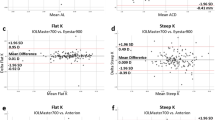Abstract
The purpose of the study was to compare the accuracy of various biometric formulas for predicting postoperative refraction determined using applanation A-scan ultrasound. This retrospective comparative study included 485 eyes that underwent uneventful phacoemulsification with intraocular lens (IOL) implantation. Applanation A-scan ultrasound biometry and postoperative manifest refraction were obtained in all eyes. Biometric data were entered into each of the five IOL power calculation formulas: SRK-II, SRK/T, Holladay I, Hoffer Q, and Binkhorst II. All eyes were divided into three groups according to axial length: short (≤22.0 mm), average (22.0–25.0 mm), and long (≥25.0 mm) eyes. The postoperative spherical equivalent was calculated and compared with the predicted refractive error using each biometric formula. The results showed that all formulas had significantly lower mean absolute error (MAE) in comparison with Binkhorst II formula (P < 0.01). The lowest MAE was obtained with the SRK-II for average (0.49 ± 0.40 D) and short (0.67 ± 0.54 D) eyes and the SRK/T for long (0.61 ± 0.50 D) eyes. The highest postoperative hyperopic shift was seen with the SRK-II for average (46.8 %), short (28.1 %), and long (48.4 %) eyes. The highest postoperative myopic shift was seen with the Holladay I for average (66.4 %) and long (71.0 %) eyes and the SRK/T for short eyes (80.6 %). In conclusion, the SRK-II formula produced the lowest MAE in average and short eyes and the SRK/T formula produced the lowest MAE in long eyes. The SRK-II has the highest postoperative hyperopic shift in all eyes. The highest postoperative myopic shift is with the Holladay I for average and long eyes and SRK/T for short eyes.

Similar content being viewed by others
References
Shammas HJ (2004) Intraocular lens power calculations. Slack Incorporated, Thorofare, pp 7–13
Holladay JT, Prager TC, Chandler TY, Musgrove KH, Lewis JW, Ruiz RS (1988) A three-part system for refining intraocular lens power calculations. J Cataract Refract Surg 14:17–24
Retzlaff JA, Sanders DR, Kraff MC (1990) Development of the SRK/T intraocular lens implant power calculation formula. J Cataract Refract Surg 16:333–340
Hoffer KJ (1993) The Hoffer Q formula: a comparison of theoretic and regression formulas. J Cataract Refract Surg 19:700–712
Rajan MS, Keilhorn I, Bell JA (2002) Partial coherence laser interferometry vs conventional ultrasound biometry in intraocular lens power calculations. Eye 16:552–556
Sahin A, Hamrah P (2012) Clinically relevant biometry. Curr Opin Ophthalmol 23:47–53
Sheard R (2014) Optimising biometry for best outcomes in cataract surgery. Eye 28:118–125
Aristodemou P, Knox Cartwright NE, Sparrow JM, Johnston RL (2011) Formula choice: Hoffer Q, Holladay 1, or SRK/T and refractive outcomes in 8108 eyes after cataract surgery with biometry by partial coherence interferometry. J Cataract Refract Surg 37:63–71
Narváez J, Zimmerman G, Stulting RD, Chang DH (2006) Accuracy of intraocular lens power prediction using the Hoffer Q, Holladay 1, Holladay 2, and SRK/T formulas. J Cataract Refract Surg 32:2050–2053
Sanders DR, Retzlaff JA, Kraff MC, Gimbel HV, Raanan MG (1990) Comparison of the SRK/T formula and other theoretical and regression formulas. J Cataract Refract Surg 16:341–346
Acknowledgments
The authors do not have any financial or proprietary interest in a product, method, or material mentioned in the manuscript.
Author information
Authors and Affiliations
Corresponding author
Rights and permissions
About this article
Cite this article
Özcura, F., Aktaş, S., Sağdık, H.M. et al. Comparison of the biometric formulas used for applanation A-scan ultrasound biometry. Int Ophthalmol 36, 707–712 (2016). https://doi.org/10.1007/s10792-016-0195-6
Received:
Accepted:
Published:
Issue Date:
DOI: https://doi.org/10.1007/s10792-016-0195-6




